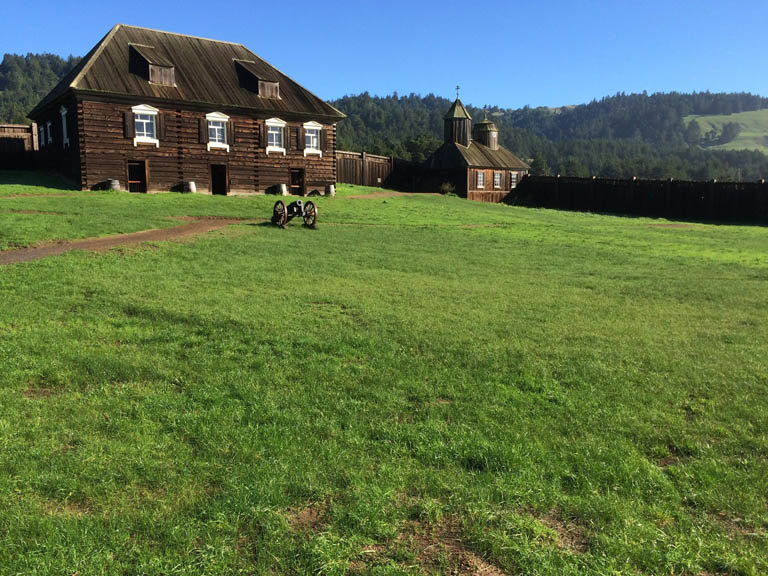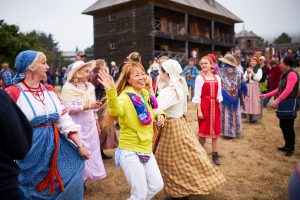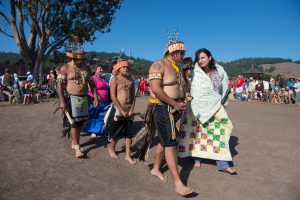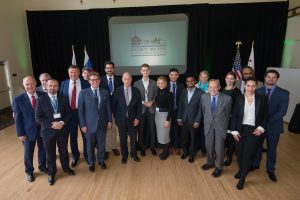ECHO Interview

Sarah Sweedler: “Fort Ross is our shared history”
206 years ago an unusual settlement sprang on the shores of California. First of all, it was founded by Russians. Second, Native Alaskans and Native Americans worked with them side-by-side. Third, it never found itself in the midst of military action or ethnic conflicts, and the stern-looking cannons were only used to greet the arriving ships. Also, the events that took place in the Fort laid a base for the famous Juno and Avos musical.
What is Fort Ross? How did the new anti-Russian sanctions affect its work? How do they survive financially and what are the different organizations working on the site? What is the Fort’s meaning in 2018? I talked about all that with Sarah Sweedler, an American whose main job is to preserve the historic Russian settlement.
So the first thing that happens when you start researching Fort Ross is a lot of different structures come up. What is the difference between Fort Ross, Fort Ross Conservancy, Fort Ross State Historic Park and Fort Ross Foundation? Who is responsible for which?
Excellent question! Fort Ross is the place itself, the 3400+ acres in Sonoma county, California. California is fortunate to have over 280 parks run by our state government and Fort Ross State Historic Park is one of them – it’s not, as many people think, a national or federal park. I am CEO of Fort Ross Conservancy (FRC), and our nonprofit organization works onsite at Fort Ross. We have a partnership with California State Parks to run programs and tours, operate the bookshop, organize big events, fundraise for projects, and more. And lastly, Fort Ross Foundation is a completely separate organization run by Renova out of New York that funds projects that fit their particular mission.

How come there’s a Russian fortress on the shores of California, and why is it sustained by Americans?
The Russians built Fort Ross in 1841, at a time when Imperial Russia was exploring the Pacific Northwest and California had not yet joined the United States. The Russian American Company had settlements in Alaska, primarily to hunt otter and other marine mammals –“soft gold,” as we say. Imagine the difficulties of going overland from St Petersburg to the Far East and then sailing the northern waters from say Okhotsk to Arkhangelsk. When the weather was bad supply ships wouldn’t arrive and the Russian settlers would suffer and sometimes die of starvation. It was Nikolai Rezanov of the famed Juno & Avos who first suggested that Russians settle north of what is now San Francisco, where he hoped the gentler climate would allow for more farming and ranching to resupply their Alaskan territories. Rezanov didn’t live long enough to know his Fort Ross idea was actually implemented, as he died traveling back to St Petersburg to ask the Czar for permission to marry Conchita, but that’s another story altogether and one that you Russians know well because of the Juno and Avos musical!
Fort Ross was an active Russian settlement from 1812-1841. From the time the Russians left until the early 1900s, what we call the early ranch era, the Russian buildings were repurposed to become a wagon stop, a saloon, a hotel, with Fort Ross as the town center. The world-famous coastal Highway One travels right by Fort Ross.
 Fort Ross State Historic Park was set aside for protection in 1906 and became a park in 1909, making it one of the earliest State Parks in California. The idea of a Russian settlement here was so unusual that early California leadership understood its importance and they wanted to preserve the unusual Russian architecture and associated history. The park history is equally interesting, especially during the Cold War era when Russian emigres couldn’t visit Russia and saw Fort Ross as a link to the homeland they lost – for those generations, Fort Ross and the Russian Orthodox chapel were particularly meaningful, a lifeline to their past. It’s worth noting that my organization has been in existence since the 1970s –which is longer than the Russian settlers lived at Fort Ross. There have been many “friends groups” at Fort Ross, and the park has always been supported by our local Russian American and Russian Orthodox communities.
Fort Ross State Historic Park was set aside for protection in 1906 and became a park in 1909, making it one of the earliest State Parks in California. The idea of a Russian settlement here was so unusual that early California leadership understood its importance and they wanted to preserve the unusual Russian architecture and associated history. The park history is equally interesting, especially during the Cold War era when Russian emigres couldn’t visit Russia and saw Fort Ross as a link to the homeland they lost – for those generations, Fort Ross and the Russian Orthodox chapel were particularly meaningful, a lifeline to their past. It’s worth noting that my organization has been in existence since the 1970s –which is longer than the Russian settlers lived at Fort Ross. There have been many “friends groups” at Fort Ross, and the park has always been supported by our local Russian American and Russian Orthodox communities.
Who were the people who worked in Fort Ross during its years of operation? How did they interact with local communities?
Fort Ross was settled by a small number of Russians and a larger number of skilled Alaska Natives whom the Russians forcibly brought down to continue hunting marine mammals. But not only them: what we call Fort Ross was – and still is– the ancestral land of the Kashia Pomo Indians. They lived in and around the coastal hills for centuries, they still live in the area, and they remain a strong and active presence at Fort Ross, which they call Metini.
The earliest history between the Russian and Kashia people is unique in that when the Russians arrived, they first asked for permission to settle on the land, and the Kashia granted them permission. The Kashia say it was, for them, their one successful treaty signed by white people.
Fort Ross was a commercial adventure and the Russians needed Kashia labor. While life in early California became impossibly difficult for all native people, at some level the Russian presence at Fort Ross was a positive influence, protecting the Kashia from the Spanish to the South. The relationship between the Kashia and the Russians was far more positive than between the Russians and the Alaska Natives, who were brought there by force. But for both communities at Fort Ross there were many unions between native peoples and Russians, and the offspring of these unions were offered an education and opportunities by the Russians.
And how come the modern Kashia retained their connection with Russia? It’s been ages since the historic Fort stopped operating as a settlement.
When the Russians left Fort Ross for good, they took their new families with them, and this is why you can find the descendants of Russians and Native Americans in some Russian cities, like Totma.

To this day the Kashia have warm and friendly relations with Russia. When the Kashia Su Nu Nu Shinal dance group was invited to tour Krasnoyarsk, Moscow, and St. Petersburg several years ago, they jumped at the chance. It’s also worth noting that the Kunstkamera Museum in St Petersburg holds the largest collection of Native California artifacts, all collected by Russian scientists during the Fort Ross era. These ties run deep.
Where does FRC gets its funding? Is it the state support, or donations, or something else?
We are a non-profit, and completely self funded – we don’t get money from the state nor the federal government. We do write grants to both American and Russian corporations and foundations for specific projects. We receive donations from our wider community, we offer fee-based programming for school kids, and we operate the bookshop at Fort Ross. And did I mention we write grants? Big and small, and very project focused. For example, I just wrote a grant for a new bike rack to be installed in front of the Visitor Center for the hundreds of cyclists who ride down Highway 1 on holiday – they don’t want their wheels stolen while touring Fort Ross. Several of our partners have been very dedicated to our work, in particular we are grateful to Russian companies Transneft and Sovcomflot, as well as Chevron for sponsoring our events and projects over the last seven years. We strive to have Fort Ross supported by both American and Russian companies as we think that best fits the park’s history and mission.
 And what does that funding allow you to do?
And what does that funding allow you to do?
We are a small organization with five full time employees. We are all dedicated to the work that we do – for example our tour guide and historical specialist Hank Birnbaum lived in Russia for many years and is fluent in Russian. A lot of staff time is spent teaching school kids about marine ecology and the history of Fort Ross. We organize lectures, volunteer work days, and big events like the annual Fort Ross Festival where several thousand people visit. I love Fort Ross Festival because it brings everyone together – the Alaska Natives, the Kashia Pomo, and the many Russians, Russian Americans, and Americans – to enjoy good company and the gorgeous place.
Are you going to experience financial difficulties after one of your major sponsors, Victor Vekselberg’s Renova, got banned from working in the US?
Renova was a great partner for many years and we are grateful to them for all the tangible projects they funded at Fort Ross. But running a nonprofit is always difficult and every year I wonder where the funding will come from. Unfortunately, it’s just part of the landscape.
Our long-term goal is to create a structure such as a trust that provides sustainable funding for Fort Ross and all our programming. With the proper infrastructural investment – simple accommodations, classrooms, and a commercial kitchen – Fort Ross could operate “in the black” while staying true to its mission.
As an NGO, do you have to be careful about where the money comes from?
Yes, we have internal guidelines about acceptable funding sources, and of course we follow American laws. Charities in the U.S. must make their financial statements available to the public each year, and we strive for transparency. I also spend a lot of energy making sure the money is used in beneficial and productive ways. That is my main goal.
Is FRC involved in politics much?
Fort Ross Conservancy’s work is to provide education and interpretation at the park, to promote the park to the widest audience possible, and to work on land stewardship projects that help the surrounding natural environment. Or put more simply, our goal is to bring people to Fort Ross to experience both the beauty and the history of this place. It’s all about the place. Yes, we work with Russian organizations and individuals – we invite them to participate, and sometimes we are fortunate to receive funding for certain projects. One happy outcome is that we have very positive experiences of working with many people in Russia. We work with common purpose on common ground. What better way than to use our past shared history to propel us towards a better future? As you can see I am doggedly and willfully optimistic on this topic.
If someone said that FRC’s sole job is to portray Russia in favorable light, and to give Russian influencers access to Americans in power, how would you reply to that?
For us on the ground at Fort Ross that just seems silly. First off, Fort Ross is not just for Russians. We have an active Kashia Pomo community, and the Alaska Natives see Fort Ross as their gathering place for diaspora Alaska Natives. Our early California ranch volunteers would also take issue with this overly simplified vision of Fort Ross. As for gaining access, I will remind our readers that we are a rural park operating on a shoestring budget with minimal infrastructure and, I might add, terrible internet. The influence is not having an overwhelming effect here at the park, of that I’m certain. It should also be noted that other historic sites in the US receive external and even governmental funding, for example the German government purchased and continues to maintain Thomas Mann’s house in Los Angeles.
I suppose I have no idea what takes place at some distance from Fort Ross, say in Washington, DC. Our job is to support the park, and that involves working with both Russians and American influencers.
What is Fort Ross Dialogue, and why did FRC take up the idea? 
Fort Ross Dialogue was created in 2012, during our bicentennial, in partnership with the Kennan Institute. It’s a one day Track-II style conference – to engage thought leaders, academics, young scholars, entrepreneurs and regional leaders on both sides of the Pacific. I was mentored by Matt Rojansky at Kennan as well as Jan Kalicki who was a consultant with Chevron as well as a Woodrow Wilson scholar to launch the conference.
FRC orchestrates panels revolving around historical and cultural components. Our partner Kennan organizes panels that touch upon policy and other track two topics.
The idea is to introduce and discuss topics of collaboration, for example bringing the Stanford US-Russia Forum students to describe their areas of study, or to bring Russian and American historians on a panel discussing Fort Ross or related historical topics. We realized that many academics, officials, and students were interested in Fort Ross. And we thought, how could we get people together each year to work on common projects and increase collaboration across borders?
How has the attitude to your work changed after the new sanctions?
There is a lot of negative press between our countries, both in the U.S. and in Russia, and that atmosphere does find its way to Fort Ross – occasionally we hear an anti-Russian comment or get questions about the park’s funding. But the majority of our visitors and neighbors are fascinated by Fort Ross’ history and grateful to our Russian sponsors for their support with events and projects. This is our shared history and both Russians and Americans are working hard to preserve and promote it. As it should be!
My attitude towards Fort Ross has not changed, but the work has gotten harder. We want to create more joint projects between Americans and Russians at Fort Ross, which is obviously more difficult in today’s political climate. More difficult but more important than ever.
Who are the people attending FRC’s public events? What do they come for?
We get visitors from across California and across globe. Many Americans are still surprised to see a Russian settlement just a few hours north of the San Francisco Bay Area. In my opinion California is very forward looking in its mindset, and people who live here broadly speaking are not quick to embrace history, maybe because we are quite a young state. But Fort Ross is becoming better known. As for Russia experts, Fort Ross has long been on the radar. I’m told that Ambassador McFaul proposed to his wife at Fort Ross, and they are still happily married. Perhaps we should hold more marriage ceremonies in the Fort Ross chapel.
 Last weekend of July you’ve celebrated 206 years of Fort Ross. How many people were there? Did a lot of Russians come?
Last weekend of July you’ve celebrated 206 years of Fort Ross. How many people were there? Did a lot of Russians come?
In the last year or two we’ve seen a drop in visitation from Russia travelers, probably because it’s so difficult to get a visa these days, and perhaps because of the exchange rate, unfortunately. But at last weekend’s Fort Ross Festival, Russian was definitely the predominant language that you heard at the park. In total we had over 3000 visitors. Here is a link to a video of the highlights of this year’s festival by our videographer Paul C Miller.
Why do you think FRC is important right now? Why is it worth preserving?
Fort Ross provides the common ground that can keep us all talking and working together. It was Ambassador Schvidkoy who reminded us – and I paraphrase poorly here – that by partnering on historical projects at Ross we create a new, contemporary story, today’s history. With a shared project we create trust and build relationships, and that trust can be transferred to other arenas. I truly don’t see the downside.
It’s been fascinating to see how the century-old relationship between emigres, Fort Ross, and Russia changes depending on the political climate. I hope someday scholars will study the contemporary history of Fort Ross – they will not be disappointed!